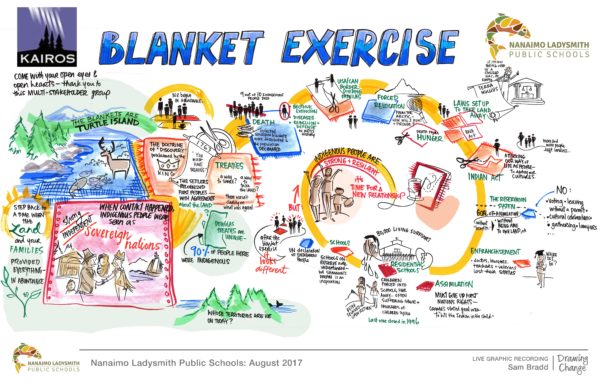Cultivating Cultural Safety in Education: visualizing histories to support Truth and Reconciliation
I recently had the privilege and pleasure to work with the Nanaimo & Ladysmith School Board during a conversation about Reconciliation. Graphic facilitation can help support open discussion around challenging issues, and organizations can use it as a methodology to affect meaningful change – just like the transformative Kairos Blanket Exercise and four other tools below.

The school board invited a wide range of Indigenous organizations and partners together to facilitate a discussion about their education system. The Kairos Blanket Exercise is a powerful tool that places participants in both Indigenous and non-Indigenous roles, in relation to the history of colonization. It encourages understanding, honest communication, and builds meaningful action.

There’s a saying I’ve heard about working with issues of Reconciliation: we can’t have “Reconciliation” before we have Truth. And this means taking a look at history, first, and wrestling with the many truths of the ongoing impact of colonization on Turtle Island.

As visual practitioners, we listen and draw to connect conversations and issues, so self-reflection is important if we use time-saving symbols to stand-in for concepts. Taking a moment to examine whether these symbols actually represent a cultural generalization that could be seen as disrespectful, is an important part of our practice to reflect on and be sensitive to. While working, we need to make choices – one of the most important of these choices is to not fall back on Whiteness as the default with which to mark difference against. A familiar way of drawing may not necessarily be the best choice. Being open to change, and working with humility are all key to helping personally participate in the transformation we want to see.
Resources
Another way we can inform our practice with more cultural humility is by continuing educating ourselves on current issues, and the myriad of resources that are available to share. Here are just a few for you to consider:
Crystal Fraser and Sara Komarnisky created a powerful list of 150 Acts of Reconciliation, to be practiced during the last 150 days of 2017. The year is not over yet, and this list is an important call to action, giving small steps towards action and learning that can build to create difference. The conversations around reconciliation still have great distances to go, and this list can help people to think about Indigenous-settler relationships as they exist in our everyday lives.
Crystal and Sara have built on #150acts by collaborating to create an incredible poster series that I encourage you to take a look at, with design and art by Yukon artist Lianne Marie Leda Charlie who is Tagé Cho Hudän | Big River People (Northern Tutchone).
The San’yas Indigenous Cultural Safety Training website is also one of the leading resources in Canada. It includes the Indigenous Cultural Safety (ICS) Online Training Program, which educates participants about anti-Indigenous racism, enhances self-awareness, and strengthens skills for professionals working directly or indirectly with Indigenous people.
Cultural Safety and working towards ending anti-Indigenous racism are important tools for me as a settler as I work with Indigenous organizations and community groups. It’s important to reflect on how my work is representative of the people with whom I’m collaborating, and that I am more aware of the visual choices I make in each session. I encourage all non-Indigenous illustrators, graphic facilitators and graphic recorders interested in being a better partner to Indigenous communities where they live and work to look at what core competencies might be useful to this work – you can read more in my four part blog series here – and in my collaborative book, Drawn Together Through Visual Practice.